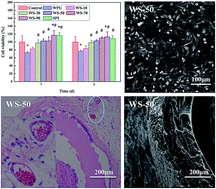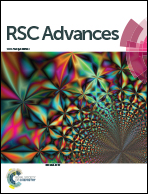Soy protein-modified waterborne polyurethane biocomposites with improved functionality
Abstract
A series of soy protein isolate (SPI)-modified waterborne polyurethane (WPU) composite films were fabricated from WPU and SPI by a process involving blending, solution casting, and evaporation. The effects of SPI content on the structure and physical properties of the composite films were characterized by Fourier transform infrared spectroscopy (FTIR), X-ray diffraction (XRD), thermogravimetric analysis (TGA), differential thermogravimetry (DTG), scanning electron microscopy (SEM), water absorption measurement, water contact angle measurement, and tensile testing. The results showed that the water absorption, hydrophilicity, and tensile strength in the dry state of the composite films increased with an increase of SPI content. The effects of SPI content on the cytocompatibility and biodegradability of the composite films were investigated by in vitro cell culture and in vivo implantation experiments. Cell culture experiments revealed that the composite films exhibited improved cytocompatibility and SPI promoted the adhesion, growth, and proliferation of cells. The in vivo implantation experiments illustrated that the composite films had improved biodegradability after modification with SPI. These results indicated that SPI-modified WPU composite films had great potential as biomaterials.


 Please wait while we load your content...
Please wait while we load your content...